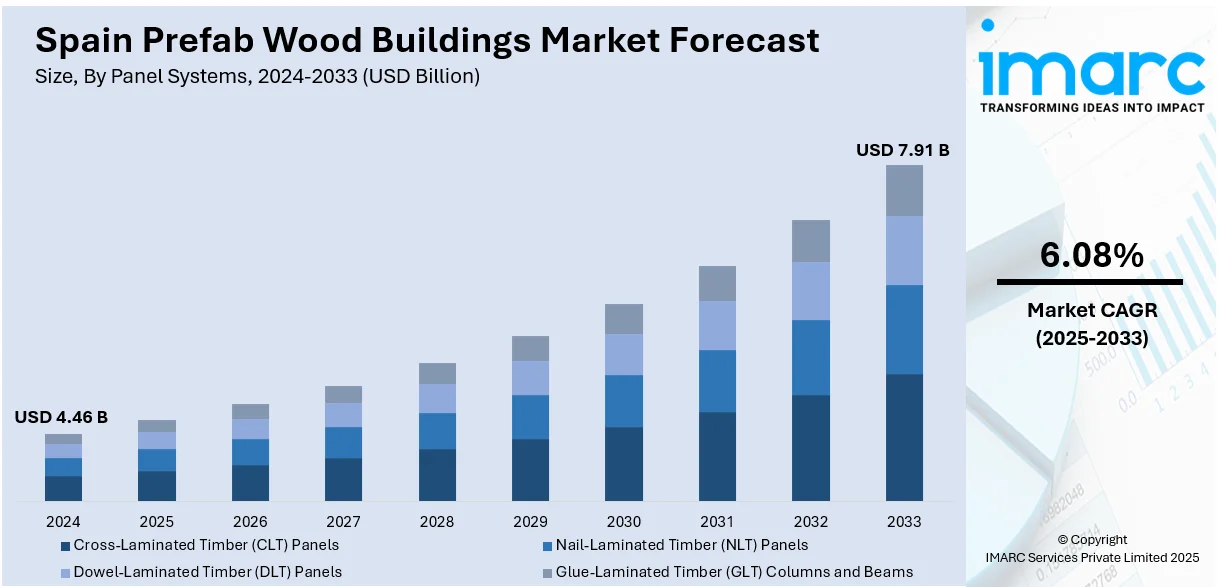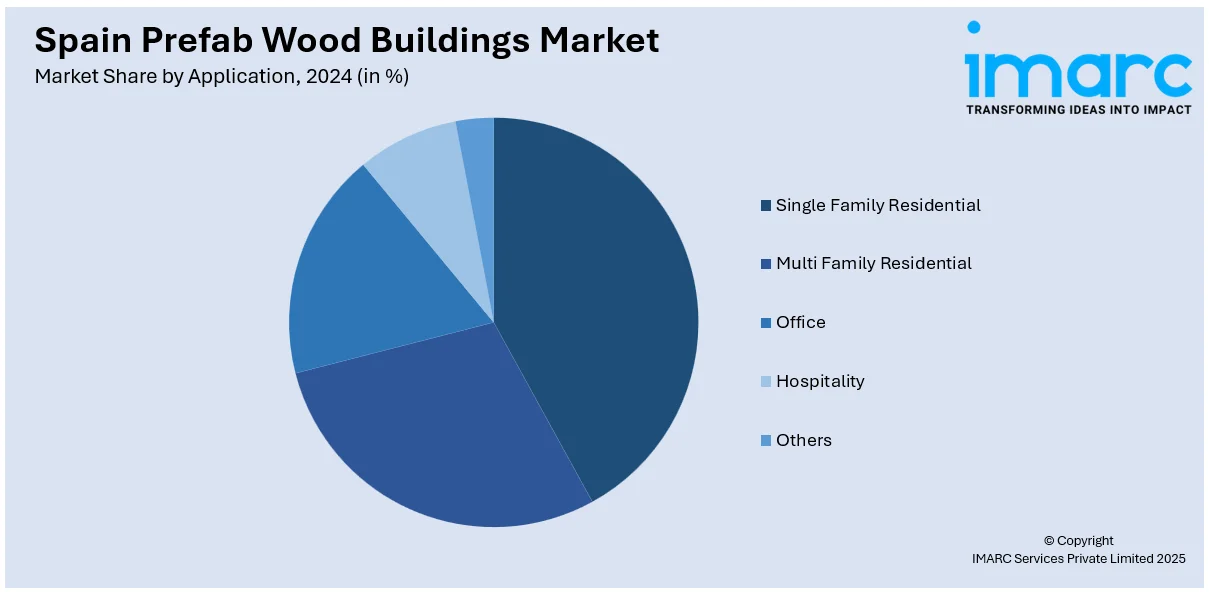
Spain Prefab Wood Buildings Market Size, Share, Trends and Forecast by Panel Systems, Application, and Region, 2025-2033
Spain Prefab Wood Buildings Market Overview:
The Spain prefab wood buildings market size reached USD 4.46 Billion in 2024. Looking forward, IMARC Group expects the market to reach USD 7.91 Billion by 2033, exhibiting a growth rate (CAGR) of 6.08% during 2025-2033. The Spain prefab wood buildings market is driven by growing government investments in sustainable housing, rising adoption of industrialized construction techniques, rising environmental awareness promoting eco-friendly materials, continuous advancements in engineered wood technology, and increasing demand for cost-effective, energy-efficient buildings that reduce construction time while aligning with EU carbon neutrality goals.
|
Report Attribute
|
Key Statistics
|
|---|---|
|
Base Year
|
2024
|
|
Forecast Years
|
2025-2033
|
|
Historical Years
|
2019-2024
|
| Market Size in 2024 | USD 4.46 Billion |
| Market Forecast in 2033 | USD 7.91 Billion |
| Market Growth Rate 2025-2033 | 6.08% |
Spain Prefab Wood Buildings Market Trends:
Government Initiatives and Investments in Affordable Housing
The Spanish government has taken the initiative to solve the country's housing problem by investing in low-cost housing solutions. The Ministry of Transport, Mobility, and Urban Agenda launched the "20,000 Housing Plan" to improve the supply of public housing at low-cost rentals. This plan highlights the government's dedication to offering affordable housing to its people. Prefabricated wood structures, being economical and fast to build, have become the go-to option in such developments. The prefabricated controlled factory environment enables efficient waste management and recycling of materials, which minimizes the ecological footprint of construction. The technique also overcomes issues associated with conventional construction, including prolonged schedules and increased expenses, making it a cost-effective option for affordable housing schemes. The focus on sustainability and efficiency is also in line with the overall European objective of carbon emission reduction and sustainable building practices.

Rising Benefits of Wood Fabrication and Sustainability Focus
Wood fabrication offers numerous advantages, including sustainability, energy efficiency, and aesthetic appeal. As environmental concerns become more prominent, there is a growing preference for eco-friendly construction materials. Wood, being a renewable resource, aligns with this shift toward sustainability. Prefabricated wood buildings also benefit from reduced construction times and costs, as modules and pieces are manufactured in a factory setting and then assembled on-site. This method not only saves time but also optimizes the use of natural resources and minimizes waste. Industrialized construction, for example, can cut delivery times by as much as 40%. Firms, such as Aedas Homes and Vía Ágora, are leading the way with these methods, pointing to a shift toward more sustainable and efficient construction. This shift is not only in response to environmental issues but also to the changing requirements of the construction industry. Conventional construction practices are plagued by labor shortages, unpredictable weather, and wastage of materials, all of which contribute to delays and added costs. Prefabricated wood construction resolves these problems by enabling higher accuracy, minimizing material wastage, and making sure that buildings are highly energy efficient.
Spain Prefab Wood Buildings Market Segmentation:
IMARC Group provides an analysis of the key trends in each segment of the market, along with forecasts at the region/country level for 2025-2033. Our report has categorized the market based on panel systems and application.
Panel Systems Insights:
- Cross-Laminated Timber (CLT) Panels
- Nail-Laminated Timber (NLT) Panels
- Dowel-Laminated Timber (DLT) Panels
- Glue-Laminated Timber (GLT) Columns and Beams
The report has provided a detailed breakup and analysis of the market based on the panel systems. This includes cross-laminated timber (CLT) panels, nail-laminated timber (NLT) panels, dowel-laminated timber (DLT) panels, and glue-laminated timber (GLT) columns and beams.
Application Insights:

- Single Family Residential
- Multi Family Residential
- Office
- Hospitality
- Others
A detailed breakup and analysis of the market based on the application have also been provided in the report. This includes single family residential, multi family residential, office, hospitality, and others.
Regional Insights:
- Northern Spain
- Eastern Spain
- Southern Spain
- Central Spain
The report has also provided a comprehensive analysis of all the major regional markets, which include Northern Spain, Eastern Spain, Southern Spain, and Central Spain.
Competitive Landscape:
The market research report has also provided a comprehensive analysis of the competitive landscape. Competitive analysis such as market structure, key player positioning, top winning strategies, competitive dashboard, and company evaluation quadrant has been covered in the report. Also, detailed profiles of all major companies have been provided.
Spain Prefab Wood Buildings Market News:
- November 2024: Erazo Pugliese and CESUGA designed a modular wooden installation in Feáns, Spain, using prefabricated timber frames and translucent fabrics to create a flexible architectural space. This project demonstrates the versatility and sustainability of prefab wood construction, encouraging wider adoption in Spain. Such innovations drive market growth by showcasing efficient, eco-friendly building solutions.
- March 2024: Gurea Arquitectura Cooperativa completed the Cork and Wood House, a 175-square-meter residence in Spain that features a minimalist material palette. The home is constructed using a prefabricated laminated wood frame, which is predominantly covered in cork panels. This design choice reflects the hues and textures of the region's traditional stone architecture.
Spain Prefab Wood Buildings Market Report Coverage:
| Report Features | Details |
|---|---|
| Base Year of the Analysis | 2024 |
| Historical Period | 2019-2024 |
| Forecast Period | 2025-2033 |
| Units | Billion USD |
| Scope of the Report | Exploration of Historical Trends and Market Outlook, Industry Catalysts and Challenges, Segment-Wise Historical and Future Market Assessment:
|
| Panel Systems Covered | Cross-Laminated Timber (CLT) Panels, Nail-Laminated Timber (NLT) Panels, Dowel-Laminated Timber (DLT) Panels, Glue-Laminated Timber (GLT) Columns and Beams |
| Applications Covered | Single Family Residential, Multi Family Residential, Office, Hospitality, Others |
| Regions Covered | Northern Spain, Eastern Spain, Southern Spain, Central Spain |
| Customization Scope | 10% Free Customization |
| Post-Sale Analyst Support | 10-12 Weeks |
| Delivery Format | PDF and Excel through Email (We can also provide the editable version of the report in PPT/Word format on special request) |
Key Questions Answered in This Report:
- How has the Spain prefab wood buildings market performed so far and how will it perform in the coming years?
- What is the breakup of the Spain prefab wood buildings market on the basis of panel systems?
- What is the breakup of the Spain prefab wood buildings market on the basis of application?
- What are the various stages in the value chain of the Spain prefab wood buildings market?
- What are the key driving factors and challenges in the Spain prefab wood buildings?
- What is the structure of the Spain prefab wood buildings market and who are the key players?
- What is the degree of competition in the Spain prefab wood buildings market?
Key Benefits for Stakeholders:
- IMARC’s industry report offers a comprehensive quantitative analysis of various market segments, historical and current market trends, market forecasts, and dynamics of the Spain prefab wood buildings market from 2019-2033.
- The research report provides the latest information on the market drivers, challenges, and opportunities in the Spain prefab wood buildings market.
- Porter's five forces analysis assist stakeholders in assessing the impact of new entrants, competitive rivalry, supplier power, buyer power, and the threat of substitution. It helps stakeholders to analyze the level of competition within the Spain prefab wood buildings industry and its attractiveness.
- Competitive landscape allows stakeholders to understand their competitive environment and provides an insight into the current positions of key players in the market.
Need more help?
- Speak to our experienced analysts for insights on the current market scenarios.
- Include additional segments and countries to customize the report as per your requirement.
- Gain an unparalleled competitive advantage in your domain by understanding how to utilize the report and positively impacting your operations and revenue.
- For further assistance, please connect with our analysts.
 Inquire Before Buying
Inquire Before Buying
 Speak to an Analyst
Speak to an Analyst
 Request Brochure
Request Brochure
 Request Customization
Request Customization




.webp)




.webp)












